Related Research Articles

The French Foreign Legion is an elite corps of the French Army created to allow foreign nationals into French service. The Legion was founded in 1831 and today consists of several specialties, namely infantry, cavalry, engineers, and airborne troops. It formed part of the Armée d’Afrique, French Army units associated with France's colonial project in North Africa, until the end of the Algerian War in 1962.
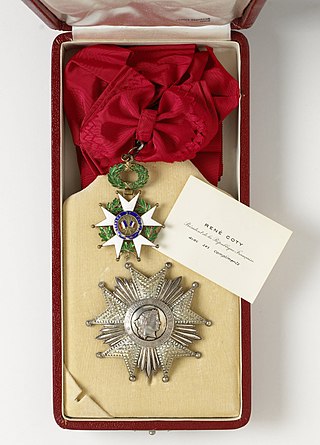
The National Order of the Legion of Honour, formerly the Imperial Order of the Legion of Honour, is the highest French order of merit, both military and civil, and currently comprises five classes. Established in 1802 by Napoleon Bonaparte, it has been retained by all later French governments and regimes.

The Swiss mercenaries were a powerful infantry force constituted by professional soldiers originating from the cantons of the Old Swiss Confederacy. They were notable for their service in foreign armies, especially among the military forces of the kings of France, throughout the early modern period of European history, from the Late Middle Ages into the 19th century. Their service as mercenaries was at its peak during the Renaissance, when their proven battlefield capabilities made them sought-after mercenary troops. There followed a period of decline, as technological and organizational advances counteracted the Swiss' advantages. Switzerland's military isolationism largely put an end to organized mercenary activity; the principal remnant of the practice is the Pontifical Swiss Guard at the Vatican.
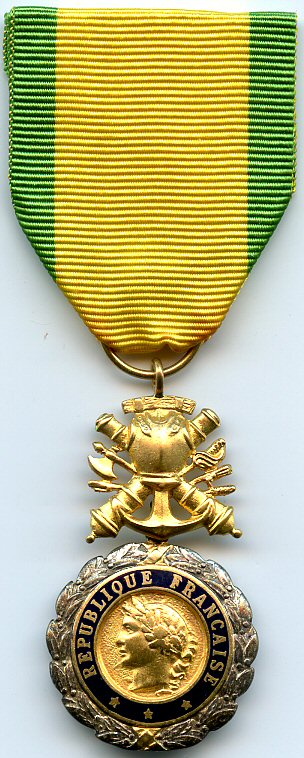
The Médaille militaire is a military decoration of the French Republic for other ranks for meritorious service and acts of bravery in action against an enemy force. It is the third highest award of the French Republic, after the Legion of Honour, a civil and military order, and the Order of Liberation, a Second World War-only order. The Médaille militaire is therefore the most senior entirely military active French decoration.

For centuries, Spain recruited foreign soldiers to its army, forming the foreign regiments such as the Regiment of Hibernia. However, the specific unit of the Spanish Army and Spain's Rapid Reaction Force, now known as the Spanish Legion, and informally known as the Tercio or the Tercios, is a 20th-century creation. It was raised in the 1920s to serve as part of Spain's Army of Africa. The unit, which was established in January 1920 as the Spanish equivalent of the French Foreign Legion, was initially known as the Tercio de Extranjeros, the name under which it began fighting in the Rif War of 1921–1926.

Prince Dimitri Zedginidze-Amilakhvari, more commonly known as Dimitri Amilakhvari was a French military officer of noble Georgian descent and Lieutenant Colonel of the French Foreign Legion. Under the nickname "Bazorka", he became an iconic figure who played an influential role in the Free French Forces fight against the Nazis in World War II.

Eugene Jacques Bullard was one of the first African-American military pilots, although Bullard flew for France, not the United States. Bullard was one of the few black combat pilots during World War I, along with William Robinson Clarke, a Jamaican who flew for the Royal Flying Corps, Domenico Mondelli from Italy, and Ahmet Ali Çelikten of the Ottoman Empire. Also a boxer and a jazz musician, he was called "L'Hirondelle noire" in French.
Hélie Denoix de Saint Marc or Hélie de Saint Marc, was a senior member of the French Resistance and a senior active officer of the French Army, having served in the French Foreign Legion, in particular at the heart and corps of the Foreign Airborne Battalions and Regiments, the heirs of the 2nd Foreign Parachute Regiment 2ème REP, a part constituent of the 11th Parachute Brigade. Commandant by interim of the 1st Foreign Parachute Regiment 1er REP, Hélie assumed full responsibility for commanding exclusively his regiment towards the Generals' Putsch in April 1961 and would be charged for such action while also distancing accusations that would compromise the integrity of the men acting under his direct orders of command. He was rehabilitated within his civilian and military rights in 1978 and awarded the high distinction of the Grand-Croix of the Legion of Honor on 28 November 2011.

The fourragère is a military award, distinguishing military units as a whole, in the form of a braided cord. The award was first adopted by France, followed by other nations such as the Netherlands, Belgium, Portugal, and Luxembourg. Fourragères have been awarded to units of both national and foreign militaries, except for that of Luxembourg, which has not been awarded to any foreign units.

Charles Emmanuel Marie Mangin was a French general during World War I.
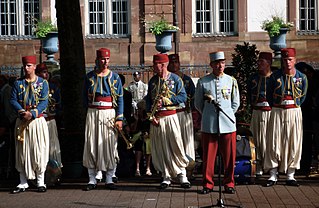
A tirailleur, in the Napoleonic era, was a type of light infantry trained to skirmish ahead of the main columns. Later, the term "tirailleur" was used by the French Army as a designation for indigenous infantry recruited in the French colonial territories during the 19th and 20th centuries, or for metropolitan units serving in a light infantry role.

Colonial troops or colonial army refers to various military units recruited from, or used as garrison troops in, colonial territories.
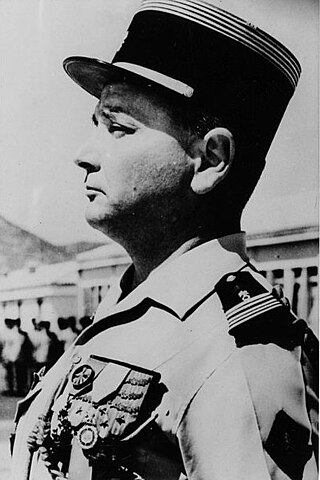
Paul Marie Félix Jacques René Arnaud de Foïard was a général in the French Army who served primarily in the French Foreign Legion taking part in World War II and the conflicts of Indochina and Algeria.
Marcel Jean Marie Alessandri was a French army officer who served in the World War I, World War II, and the First Indochina War. During World War II, he was stationed in French Indochina where he ultimately assumed supreme command of the French forces in China, in addition to assuming responsibility for the administration of the French government in China. In the course of his military career he received the Croix de Guerre twelve times in addition to numerous other citations and commendations.
Jeannou Lacaze, was a French Général d'armée of the French Army and Chef d'État-Major des armées (1981-1985), who also served in the French Foreign Legion.
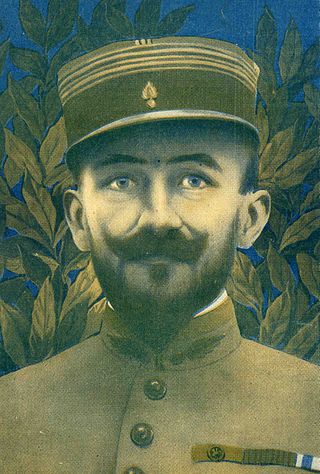
Paul-Frédéric Rollet (1875–1941) was a French Army Général who led in the Marching Regiment of the Foreign Legion RMLE, and was the 1st Inspector of the Foreign Legion, a post which he created under his intentions. Rollet accumulated 41 years of military service out of which 33 were in the Legion and also planned the 100th anniversary of the legion on Camerone day of 30 April 1931. Consequently, he was responsible for creating many of the Legion's current traditions.

Roger Louis Faulques, also known as René Faulques, was a French military officer and mercenary. A graduate of the École spéciale militaire de Saint-Cyr, he served as a paratrooper officer in the French Foreign Legion, and later as a mercenary in conflicts in Africa and the Middle East. He fought in the Second World War, the First Indochina War, the Suez Crisis, the Algerian War, the Congo Crisis, the North Yemen Civil War and the Nigerian Civil War. He is one of France's most decorated soldiers.
Pierre Georges Fernand Darmuzai was a French Général who served an entire career in the formation of the Parachute Battalions and Regiments BEPs and REPs of the Foreign Legion.

Basilio José Segundo "Basil" Pica Valdes was a Filipino doctor, general and minister. Valdes was chief of staff of the Armed Forces of the Commonwealth of the Philippines from 1939, and was in 1941 appointed Secretary of National Defense by President Manuel L. Quezon. After the Japanese invasion of the Philippines at the beginning of the Second World War, he was one of the members of Quezon's war cabinet in exile.
References
- De Vera, Ruel S. The Zero Hour: The Personal War of Basilio J. Valdes. Makati: Bookmark, 2001.
- Foreign Service Institute. Philippine External Relations: A Centennial Vista. Pasay: Foreign Service Institute, 1998.
- Young, John Robert. The French Foreign Legion: the Inside Story of the World-Famous Fighting Force. Introduction by Len Deighton. London: Thames and Hudson, 1984.